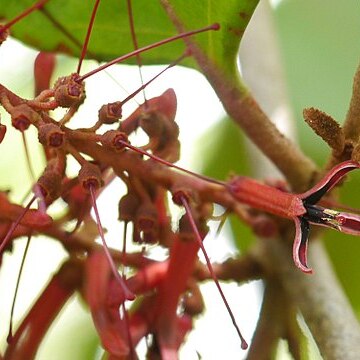Shrubs parasitic, glabrous or with stellate hairs and glabrescent. Leaves opposite or alternate, rarely subwhorled, pinnately veined. Inflorescences axillary, rarely terminal, racemes or spikes; 1 bract subtending each flower. Flowers bisexual, 4-6-merous, actinomorphic, sessile or pedicellate. Calyx limb 4-6-denticulate, persistent. Mature flower bud straight, basal 1/2 usually slightly inflated and angled, distal portion usually subclavate. Corolla red, pink, orange, or yellowish, petals free, straight, spreading. Stamens usually inserted at middle of the petals. Filaments short; anthers 2-4-loculed, sometimes multilocellate, ellipsoid. Pollen grain semiangular or semilobate in polar view. Ovary 1-loculed; placentation basal. Style subcylindric, 4-6-angled; stigma capitate or truncate. Berry ovoid or ellipsoid, exocarp leathery, smooth or pubescent.
Aerial stem-parasitic shrubs, sometimes with epicortical runners bearing secondary haustoria, or rarely (not in Malesia) terrestrial root parasites. Leaves opposite, scattered or sometimes crowded to false whorls. Inflorescence a simple raceme or spike; bracts single under each flower. Corolla 4-to 6-merous, choripetalous, regular or nearly so. Anthers basifixed, immobile. Style straight, simple or with a constriction separating upper and lower segments with different outlines; stigma knob-like. Fruit ovoid. Fig. 26. Fig. 27.
Flowers usually in terminal and/or axillary racemes or spikes, elsewhere sometimes crowded at apex of peduncle and subumbellate, 4-merous in Africa; bract unilateral to cupular, with a small ovate-triangular limb, often umbonate.
Petals separate, white, yellow or red, but not conspicuously banded; lower part erect, generally thickened, sometimes calloused inside at top; upper longer part caudate to spathulate, spreading to reflexed.
Stamens erect, normally arising from top of lower part of petal, sometimes higher; anthers shorter or longer than filament, 2–4-thecous, sometimes locellate.
Mostly small shrubs from a single haustorial attachment in Africa, essentially glabrous in Africa; twigs terete, flattened or angular.
Leaves opposite to alternate, sessile to petiolate, usually penninerved.
Style angular, slender in Africa; stigma small to capitate (in Asia).
Calyx rim-like to cupular, subentire to slightly toothed.
Berries round to ellipsoid, smooth or warted.

